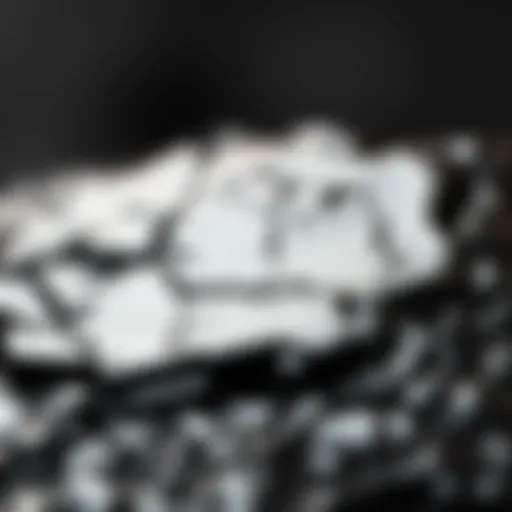Exploring Rutilated Crystals: Properties and Significance
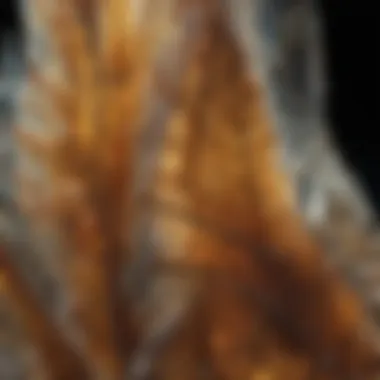
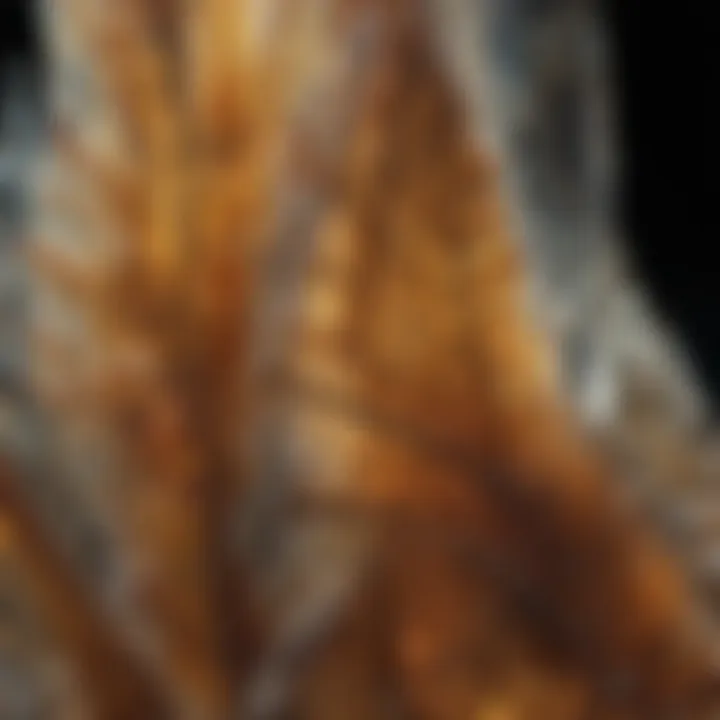
Intro
Rutilated crystals are nature’s fascinating creations, embodying complex beauty and magnetic allure. While most people are familiar with gemstones that glimmer in a polished state, the unique inclusion of rutile—known for its needle-like strands—adds a rich narrative to the story of these crystals. Enthusiasts and collectors alike find themselves drawn to the intricate patterns and the metaphysical properties commonly attributed to rutilated quartz. This article seeks to peel back the layers of these gems, revealing not just their visual appeal but also their significant history and cultural implications. Let's embark on a journey of exploration.
History and Origins
Overview of Collectibles, Rocks, and Fossils
From the dawn of civilization, humans have held an enduring fascination with stones and crystals. Some cultures saw them as talismans, while others appreciated them purely for their aesthetic appeal. Rutilated crystals, particularly, have found their place in both art and spirituality, intertwining narratives about human history with the natural world. Collectors cherish them not only for their striking appearance but also for the stories they encompass.
Historical Significance and Cultural Impact
Rutilated quartz has roots in various cultures, where it has played diverse roles, from being used in ceremonial practices to simply adorning the elite. Ancient Romans may have donned rutilated pieces believing they brought good luck, while in Chinese culture, it was associated with strength and vitality. The use of such crystals in different practices highlights a common theme—human beings find connection and meaning in nature.
"The beauty of minerals and crystals is not just in their structure, but in the stories they tell us about the earth and our place within it."
Similarly, in modern alternative healing practices, rutilated crystals are believed to assist in spiritual growth, attracting positive energy while dispelling negativity. As these beliefs continue to evolve, the popularity of rutilated quartz among both collectors and practitioners remains steadfast.
Identification and Classification
Guide to Identifying Rocks and Fossils
When it comes to identifying rutilated quartz, a few well-defined properties can help enthusiasts spot a genuine piece.
- Visual Features: Look for the characteristic rutile inclusions—often golden to reddish-brown—that run through the quartz. These give the stone a unique character, setting it apart from other quartz varieties.
- Transparency: High-quality rutilated quartz will usually have a level of clarity, allowing you to see the rutile inclusions without much obstruction.
- Weight: Compared to various other stones, rutilated quartz is relatively light, especially when it comes to larger specimens.
Common Types and Variations
Rutilated quartz comes in several varieties, each with its distinct attributes:
- Golden Rutilated Quartz: Featuring golden needle-like inclusions, it's one of the most sought after for both aesthetic and perceived healing purposes.
- Red Rutilated Quartz: Known for its vibrant red inclusions, this type is often linked to enhancing passion and energy.
- Black Rutilated Quartz: A rarer variation, characterized by black rutile, believed to offer strong grounding effects.
Preface to Rutilated Crystal
Rutilated crystal captivates many, bridging earth's age-old secrets to contemporary applications. Their unique beauty lies not merely in their aesthetics; it's woven into the geological and metaphysical attractions they possess. By understanding these renowned crystals, collectors and enthusiasts appreciate not only their visual appeal but also their deeper significance and uses.
Identifying rutilated crystals involves acknowledging their distinct rutile inclusions—those fine, needle-like strands of titanium dioxide—helping distinguish them from the usual quartz samples. These inclusions not only transform the appearance but are deeply tied to the stone’s believed energetic properties. The allure of rutilated crystal is profound, offering benefits that span aesthetic pleasure to claims of metaphysical healing properties, attracting a diverse audience.
This section sets the stage for understanding what rutilated crystals are and highlights their scientific basis. Gaining insight into these elements encourages collectors to make informed choices while fostering appreciation for the geology and culture that surround these crystals.
Defining Rutilated Crystal
Rutilated crystal is essentially a form of quartz that showcases prominent inclusions of rutile, a mineral known for its striking golden, reddish, or black fibers. This merging of quartz and rutile creates stones that are both visually stunning and hydrating for the curious mind. When light passes through, the internal rutile can cast beautiful reflections, enhancing the natural beauty of the crystal. It’s almost like having a tiny universe encapsulated within, where each crystal tells its own story.
When examining a rutilated crystal, its striations and patterns often evoke thoughts and emotions. The diversity in their appearance can vary significantly from a subtle shimmer to a dramatic entanglement of fine threads, making each piece unique. Collectors not only seek these specimens for their beauty but also due to the growing lore surrounding rutilated stones, which claim to harbor energies and healing capabilities.
The Science Behind the Rutile Phenomenon
Delving into the science behind the rutile phenomenon reveals a fascinating interplay of geology and mineralogy. Rutiles are composed of titanium dioxide and can form in various geological environments, often as a metamorphic by-product. Over time, this robust mineral finds its way into quartz crystals, creating those eye-catching inclusions that we see.
This synergy occurs through a natural process called crystallization, where minerals can form and deposit in other crystals over long geological periods. So, when we admire a piece of rutilated crystal, we’re not merely looking at a stone; we’re witnessing the culmination of Earth’s intricate workings, sometimes spanning millions of years.
Understanding the formation process can also lead to better appreciation for authenticity. Collectors armed with this knowledge are likely to seek out genuine pieces, recognizing that each rutilated crystal serves as a time capsule—a record of our planet’s dynamic history.
"Rutilated crystals act like nature's artwork, combining the splendor of quartz with the fiery threads of rutile, bringing together beauty and geological history into one package."
Through this lens, it becomes clear why enthusiasts gather these stones. Rutilated crystals thus bridge aesthetic beauty with inherent value, making them not just decorative gems but treasures of Earth’s geological past.
Geological Origins of Rutilated Crystals
Understanding the geological origins of rutilated crystals offers profound insights into not only their physical attributes but also their mystical and cultural significance. The way these crystals form can shed light on the environments and conditions that produce them. This makes it crucial for collectors and enthusiasts alike to grasp how geological processes contribute to the creation of rutilated crystals, thereby enhancing their appreciation.
Formation Processes

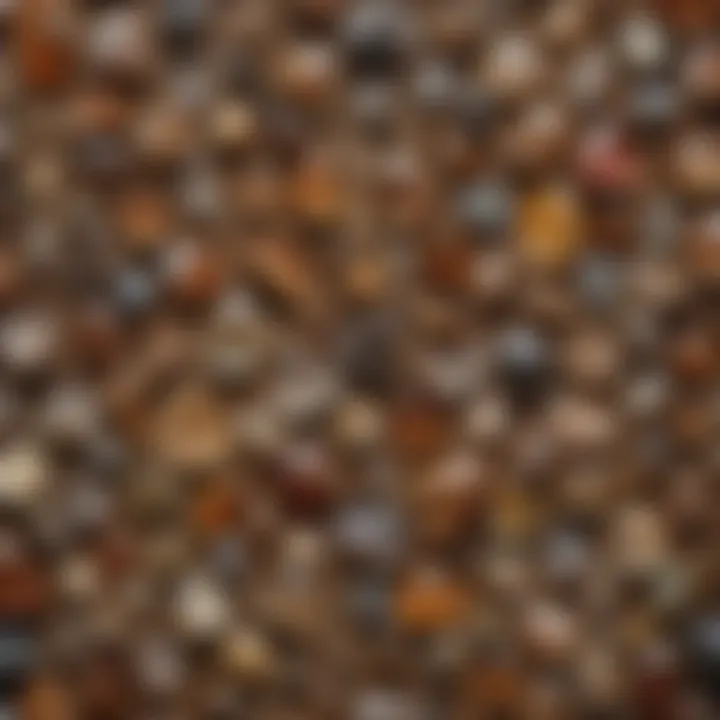
Rutilated crystals are not simply born from the earth’s depths; their formation involves intricate natural processes that often take millions of years. At the heart of this complex metamorphosis is the formation of rutile, a mineral primarily composed of titanium dioxide. Rutile forms in high-temperature and -pressure environments, often alongside other minerals. It can appear as delicate, needle-like inclusions within quartz, producing the distinctive appearance that collectors find appealing.
The initial phase begins with the crystallization of quartz, where silica crystals slowly cool and settle over time. During this phase, rutile may infiltrate the quartz matrix through hydrothermal processes. In layman’s terms, think of it as the quartz being a sponge soaking up minerals from its liquid surroundings. The minerals that find their way into the quartz shapes the character and charm of the finished crystal.
To get more granular, the geological settings that promote the formation of rutile include metamorphic environments and regions with volcanic activity. Typically, regions that have been subjected to intense heat and pressure, like the Appalachian Mountains in the USA or the alpine regions of Europe, are prime spots for discovering rutilated crystals.
Common Localities for Rutilated Crystals
Rutilated crystals can be found across the globe, shining a light on the vast diversity of our planet’s geological features.
- Brazil: Known for producing stunning, golden rutile inclusions. Brazilian specimens often exhibit long, striking needle formations that capture the light exquisitely.
- United States: Notably, areas in Arkansas and the Appalachian Mountains yield an array of rutilated quartz, appreciated for their unique textures and colors.
- Italy: In the Dolomites, collectors look for delicate rutilated quartz that often features intricate and colorful inclusions resulting from unique geological reactions.
- Madagascar: This region has become famous for its vibrant and eye-catching pieces that display a variety of rutile colors and formations.
- Russia: Known for allowing the formation of large, well-formed crystals, Russian specimens hold significant value in both the collecting and gem markets.
"Understanding where rutilated crystals originate helps enthusiasts appreciate their journey through time and earth, making cada piece a history lesson itself".
Grasping the geological origins of rutilated crystals not only educates collectors but also fosters a deeper connection with these magnificent natural wonders. As we traverse through the next sections, the importance of understanding these origins will only amplify the appreciation for rutilated crystals.
Characteristics of Rutilated Crystals
Understanding the characteristics of rutilated crystals is essential for both enthusiasts and collectors. These features not only define the aesthetic appeal of the crystals but also influence their significance in various practices, including healing and art. Knowledge of these traits helps anyone appreciate the beauty and functionality of these unique gemstones.
Physical Properties
Rutilated crystals are primarily recognized for their striking appearances. They often exhibit a transparent to translucent quality, with glittering golden or reddish needle-like inclusions of rutile. The contrast between the dark body of the host crystal—generally quartz—and the bright rutile needles can create stunning visual effects. Notably, the length, density, and orientation of these rutile inclusions can vary widely from stone to stone, leading to a captivating diversity in each piece.
Moreover, rutilated quartz displays a hardness of 7 on the Mohs scale, which makes it relatively durable. This level of hardness allows enthusiasts to use the crystals in everyday jewelry without the constant worry of breakage. The interplay of light within these crystals often leads to phenomena such as chatoyancy, where a silken sheen glides across the surface when viewed from different angles.
Many collectors often find large rutilated pieces particularly appealing. Larger stones not only stand out but also tend to exhibit more complex arrangements of rutile inclusions. In addition, the size of these crystals can profoundly affect their perceived value in the mineral market, with larger, well-formed specimens fetching greater prices.
Color Variations and Their Implications
The coloration of rutilated crystals can vary, influencing both their desirability and symbolic meanings across cultures. While the most common color for rutile inclusions is golden yellow, variations range from a deep red to a more subtle silver. Each hue carries its own significance and aesthetic appeal. For example, golden inclusions are often associated with prosperity and clarity, while darker tones may symbolize grounding and strength.
- Gold: Symbolizes success and confidence. Many believe it brings positive energy.
- Red: Often connected to passion and vitality. This shade is thought to enhance creative energy.
- Silver: Represents clarity and focus, serving as a reminder to seek balance.
The presence of these various colors also reflects the environmental conditions during the crystal's formation. For instance, a darker rutilated quartz may originate from a more mineral-rich environment, indicating that the surrounding matrix had a significant impact on its color and growth.
Collectively, these characteristics not only lend themselves to the rutilated crystal's physical beauty but also influence its perceived value in metaphysical practices. The unique combination of inclusions, coloration, and the overall craftsmanship of the crystal plays an important role in the mind of the collector or user.
"Rutilated crystals serve as a remarkable intersection of beauty, science, and spirituality, making them increasingly sought after in both the art of collecting and holistic practices."
Through understanding the captivating characteristics of rutilated crystals, enthusiasts can better appreciate their value in both collectible geology and the broader realms of art and spirituality.
Cultural and Historical Significance
The realm of rutilated crystals is not only fascinating due to their physical beauty and geological formation, but their cultural and historical significance also plays a key role in understanding human connections to this mineral. Rutilated crystals have seen varied uses across cultures, invoking spirituality, mysticism, and artistry. Through the ages, these stones have been valued not just for their aesthetic appeal but for the beliefs attached to their properties and their roles in ancient practices.
Ancient Uses in Various Cultures
Historically, rutilated crystals were revered in many societies for supposed metaphysical properties. In ancient Rome, these gems were often worn as talismans, thought to offer protection against malevolent forces. People believed that the rutile inclusions, resembling fine golden threads, held the power to channel energy and promote mental clarity.
- Egyptians: In ancient Egypt, crystals were commonly associated with the gods. Rutilated quartz was sometimes found among burial treasures, suggesting it was included for spiritual guidance in the afterlife, further emphasizing its believed significance.
- Chinese Culture: In China, the belief in Feng Shui guides much of how crystals are utilized. Rutilated quartz is said to attract positive energy while dispelling negativity, making it a popular choice among practitioners of this ancient art. The rutiles are considered to enhance personal power and intuition, therefore integrating well into various rituals.
- Indigenous Practices: Native American tribes also valued rutilated crystals for their connection to the earth. They were used in healing rituals, often believed to assist in personal transformation by encouraging the flow of energy throughout the body.
Across these diverse examples, it is clear that rutilated crystals have been emblems of strength and change, resonating strongly with those who sought their energetic properties.
Modern Trends in Spiritual Practices
Today, the fascination with rutilated crystals continues to grow, particularly within the spiritual and holistic communities. As people seek natural remedies and tools for personal growth, these gems have found new life in modern practices.
- Meditation and Mindfulness: Many individuals utilize rutilated crystals during meditation sessions. It is believed that holding or placing the crystal nearby can enhance focus and promote a state of mindfulness. The intricate rutile patterns are said to reflect the complexity of thoughts, helping individuals explore their inner selves more deeply.
- Energy Healing: Rutilated crystals are gaining fame in the realm of energy healing. Practitioners assert that the crystal amplifies one’s intentions and assists in emotional healing. They are quite popular among Reiki practitioners and crystal healers who consider them tools for channeling energy.
- Journaling and Affirmations: Combining journaling with rutilated crystals is becoming a popular trend. Individuals write down their goals and affirmations while keeping the crystal close, believing that it helps to manifest their wishes more effectively.
Rutilated crystals, thus, serve not only as decorative pieces but also as significant tools in today's spiritual landscape, showcasing a vibrant continuity from ancient beliefs to modern practices.
Applications of Rutilated Crystal
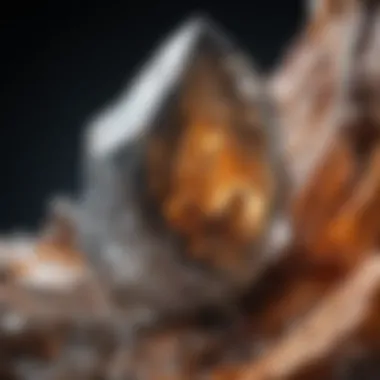
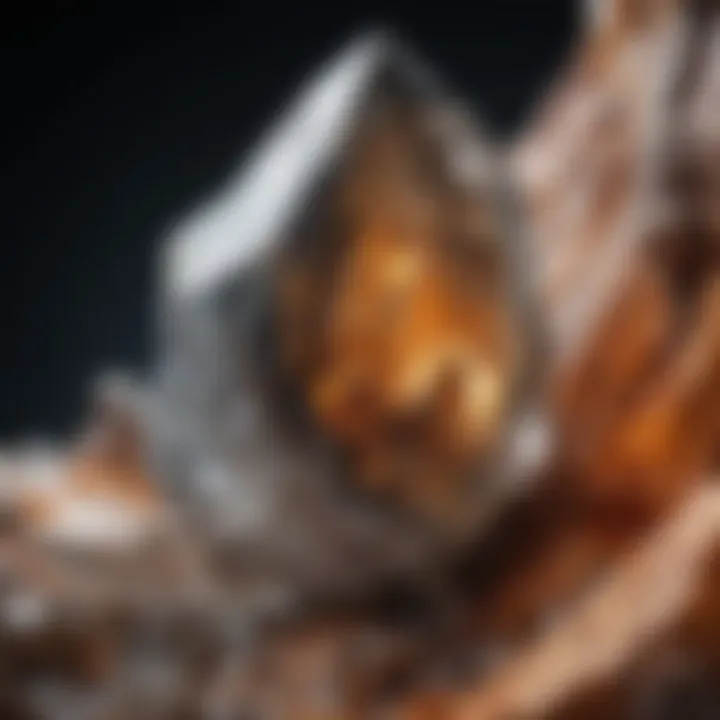
The allure of rutilated crystals transcends mere aesthetics—they embody a rich tapestry of applications that resonate with both practical and spiritual dimensions. From their purported healing properties to their stunning presence in jewelry, these unique stones capture the imagination of collectors and enthusiasts alike. Understanding the various applications of rutilated crystals not only enhances one’s appreciation of them but also reveals the underlying significance they hold across cultures and practices.
Healing Properties and Practices
Rutilated crystals are more than just decorative pieces; they are often celebrated for their believed healing properties. Many enthusiasts assert that these crystals carry the essence of vitality and renewal. The rutile inclusions, known for their fibrous appearance, are often seen as conduits for energy.
Here are some key aspects to consider:
- Energy Amplification: It is said that rutilated crystals can amplify intentions, making them a popular choice for meditation and manifestation practices. Collectors often pair these with other crystals to enhance their effects.
- Emotional Healing: Rutilated quartz, with its golden or reddish inclusions, is thought to support emotional healing, providing clarity during challenging times. Many users find solace in holding such a crystal during moments of anxiety or stress.
- Chakra Balancing: Practitioners frequently utilize rutilated quartz in chakra therapies, believing that it promotes an alignment of energies that can stimulate the flow of life force within.
In addition to these intrinsic properties, rutilated crystals are emblematic of personal empowerment. By integrating them into daily rituals or wellness practices, enthusiasts often report a deeper sense of connection with themselves and the world around them.
Uses in Jewelry and Decorative Arts
Rutilated crystals command a unique aesthetic appeal that makes them highly sought after in the realms of jewelry and decorative arts. Their distinctive patterns and colors can lend an air of sophistication to various pieces. Here’s why they stand out:
- Aesthetic Versatility: With hues ranging from smoky greys accentuated by golden rutile to fiery oranges interspersed within transparent quartz, these crystals serve as striking focal points in jewelry. Whether in necklaces, rings, or earrings, their presence is immediately arresting.
- Symbol of Uniqueness: Each rutilated crystal boasts a one-of-a-kind pattern, making any jewelry piece an individual work of art. Collectors appreciate this uniqueness, as it reflects personal style and a connection to nature.
- Integrating Tradition and Modernity: Artisans today craft contemporary jewelry that respects ancient designs while embracing fresh, innovative techniques. This fusion of styles appeals to modern consumers who seek distinctiveness in their adornments.
Moreover, rutilated crystals find a home in decorative arts as well. Spheres, obelisks, and slices are popular in holistic workspaces, enhancing not just visual aesthetics but also the overall energy of the environment.
"A rutilated crystal is more than just a gemstone; it’s a tangible piece of nature that tells a story through its patterns and colors."
Collecting Rutilated Crystals
Collecting rutilated crystals is not merely a hobby for many; it embodies a fervent passion and a pursuit of beauty found deep within the earth. Rutilated crystals, characterized by their needle-like inclusions of rutile, offer an intricate dance of light and formation. For enthusiasts, these unique specimens are more than decorative stones; they’re pieces of history formed over eons, and their allure often lies in their rarity and unique patterns. Understanding how to identify, value, and preserve them is crucial to any serious collector.
How to Identify Authentic Rutilated Crystals
When faced with a sprawl of shiny rocks, it can sometimes feel like finding a needle in a haystack when trying to identify authentic rutilated crystals. The authenticity hinges largely on observation and a few basic guidelines:
- Color and Transparency: Genuine rutilated quartz tends to be transparent to translucent, with the rutile inclusions creating a striking contrast. Colors can vary from golden-yellow to reddish-brown.
- Inclusion Patterns: Authentic specimens showcase linear patterns or needle-like structures within the crystal. Fake ones might have painted or glued lines that can easily be detected by a discerning eye. Look closely; a microscope might just give you that extra edge.
- Clarity of Rutile: Real rutile often exhibits clarity, allowing light to penetrate without cloudiness. If they seem to be trapped in a murky base, it’s possible they’re not authentic.
- Weight and Density: These crystals are usually heavier than they appear. If it feels surprisingly light, don’t be too quick to buy.
- Expert Appraisal: Consulting with seasoned gem dealers or geological experts can significantly bolster your confidence in identification. Knowledge from experts, especially in local gem shows, can provide a treasure trove of insights.
Establishing Value and Authenticity
In the realm of rutilated crystals, establishing their value isn’t just about price tags; it encompasses a blend of scientific appraisal and market demand. Factors affecting value include:
- Rarity and Quality: Just like an elusive butterfly, rarer varieties naturally garner higher prices. A piece with exquisite rutile inclusion may fetch a pretty penny compared to more common specimens.
- Condition of the Crystal: Chips, scratches, or clouding can greatly affect value. Keeping your collection pristine is akin to maintaining a classic car; every little bit adds to the overall worth.
- Provenance and Documentation: A well-documented history of a crystal’s journey can add layers of intrigue and value. If you’ve got papers or photos showing its origin, consider it a gold star in your collection.
- Market Trends: Much like the stock market, the value of rutilated crystals can fluctuate. Staying abreast of current trends through forums, local gem clubs, and auctions can inform your buying and selling strategies.
Remember, the value of a crystal is not only in its monetary worth but also in the experiences and joy it brings to collectors.
Collecting rutilated crystals can be a fulfilling journey, merging science and art while offering insight into the geological marvels of our planet. With careful attention to detail and an eye for authenticity, collectors can cultivate a remarkable ensemble that both resonates personally and holds significant value in the mineral world.
Caring for Your Rutilated Crystals
Caring for your rutilated crystals is not just a matter of keeping them shiny and clean; it’s about preserving their unique qualities and ensuring they maintain their beauty and energy. These stunning gems are not just visually appealing; they hold significance in both the metaphysical world and the realm of mineral collecting. Proper care allows collectors and enthusiasts to enjoy these pieces for many years, even generations.
When dealing with rutilated crystals, it’s essential to recognize their delicate nature, especially considering the intricacies of the rutile inclusions. Additionally, many collectors enjoy these crystals for their purported healing properties, which can be compromised if the crystals are not properly maintained.
Cleaning and Maintenance Tips
Keeping rutilated crystals clean can enhance their aesthetic appeal and energetic vibrations. Here are some tried-and-true tips:
- Gentle Washing: Use lukewarm water and a soft cloth to gently wipe the surface of the crystal to clear off dust and residue. Avoid abrasive cleaners or materials that might scratch the surface.
- Natural Soaks: Occasionally, soak your rutilated crystals in a solution of water and a few drops of mild soap. Rinse thoroughly afterward to make sure no soap residue remains, as this can dull their shine.
- Avoid Harsh Chemicals: Steer clear of using bleach or strong detergents which may harm the crystal's structural integrity.
- Smudging: Utilizing smoke from sage or incense can be an effective way to clear any negative energies from your rutilated crystal without using water. This spiritual cleansing can restore the crystal's vibrancy.
By introducing these cleaning habits into your routine, you can keep your rutilated crystals looking their best while allowing their energies to shine.
Storing Rutilated Crystals Safely
How you store your rutilated crystals is crucial to ensuring their longevity and minimizing damage. These stones can be fragile, often marked by delicate rutile strands, making it imperative to store them with care:
- Soft Pouches or Boxes: Place each crystal within a soft pouch or a padded box. This helps prevent scratches and chips. It’s wise to avoid stacking them on top of one another.
- Temperature Control: Store your crystals in a stable environment, avoiding extreme temperature fluctuations. Sudden changes can lead to cracks or stress fractures.
- Out of Direct Sunlight: While sunlight can enhance the colors of some crystals, prolonged exposure to direct light can cause rutilated crystals to fade over time. Consider a dark or shaded area for storage.
- Display Wisely: If you choose to display your crystals, make sure they are on stable surfaces and away from high-traffic areas where they could be knocked over or accidentally damaged.
Keeping these care tips in mind will not only preserve the physical beauty of your rutilated crystals but also maintain their metaphysical properties, allowing you to enjoy their unique energies for a long time.
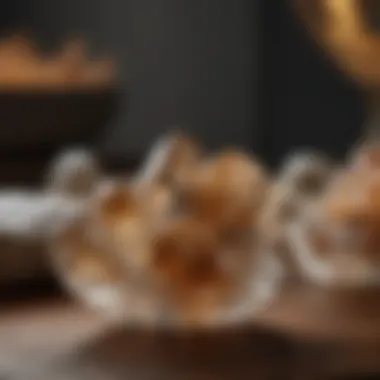
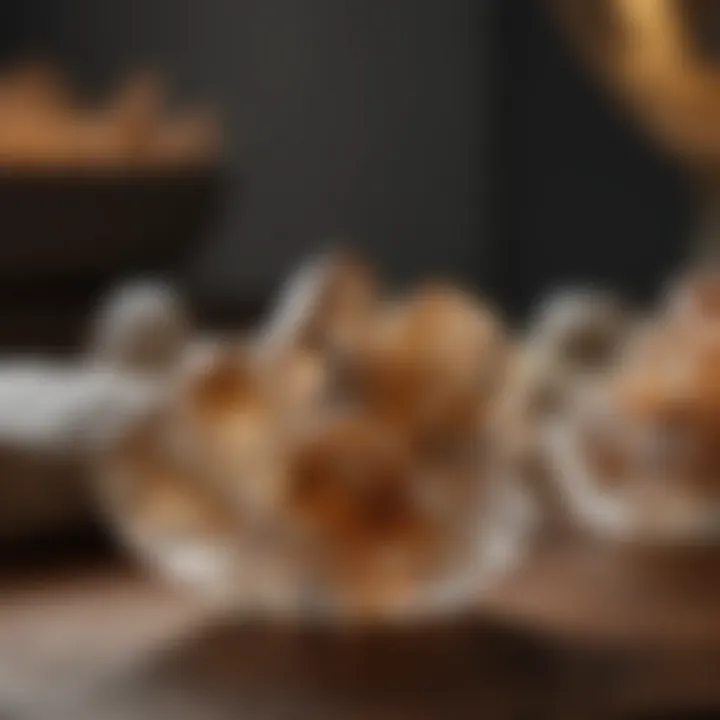
"The condition of your crystal reflects not only its worth but the care you put into it."
By following these practices, crystal collectors can ensure their rutilated specimens remain cherished possessions for years to come.
Ethical Considerations in Collecting
Collecting rutilated crystals, like any other mineral or fossil collection, brings along a burden of ethical considerations. It’s imperative to reflect on the impact of our actions on the environment and the communities involved in the sourcing of these minerals. Ethical collecting is not just a buzzword; it embodies respect for nature and acknowledgment of the cultural significance these stones can hold.
Sustainable Sourcing Practices
When we talk about sustainable sourcing, we’re essentially discussing methods that minimize environmental impact while promoting fairness in trade practices. This is particularly crucial in the world of minerals, where over-extraction can lead to habitat destruction and depletion of resources. Here are some key points to consider for responsible sourcing:
- Support Certified Dealers: Purchasing from vendors who adhere to ethical standards ensures that the crystals are obtained through sustainable practices. Look for certifications that signify adherence to eco-friendly mining practices.
- Local Sourcing: Whenever possible, opt for rutilated crystals that are sourced locally. This not only cuts down on carbon footprints but contributes to local economies. It also fosters a deeper connection to your collection, knowing its origins.
- Ask Questions: Don’t hesitate to ask where and how a seller sourced their crystals. Genuine vendors should be transparent about their practices and willing to share information about their supply chains.
Emphasizing sustainable practices not only safeguards the planet but also supports communities that depend on mineral extraction for their livelihoods.
Understanding Vendor Transparency
Transparency is the bedrock of ethical collecting. When a vendor is open about their sourcing methods, it fosters trust and accountability. A lack of transparency can raise red flags about the authenticity and ethicality of a product. Here are several aspects to consider:
- Documentation: Authentic vendors often provide documentation that illustrates how their crystals were sourced. This includes origin certificates and proof of sustainable practices, offering buyers peace of mind.
- Engagement with the Community: Vendors who engage with local communities and support their development are often more trustworthy. Such engagement shows a commitment not just to profits, but also to the well-being of the environment and the people.
- Reviews and Recommendations: Before making a purchase, it's vital to do your homework. Check reviews and recommendations from fellow collectors or communities on platforms like Reddit or Facebook regarding vendors’ reliability.
"Collecting ethically is not merely a choice, but a responsibility we hold towards our planet and its people—tread lightly, and collect mindfully."
Understanding vendor transparency goes beyond just knowing where your mineral comes from; it concerns the ethical implications of purchases and the impact they have on the wider world. By prioritizing ethical practices in collection, you're not only enhancing your passion but also contributing positively to the environment and society.
The Future of Rutilated Crystals
The journey of rutilated crystals is far from a static chapter in the annals of geology. As we look toward the horizon, it's essential to consider how shifts in art, science, and culture can shape the future of these striking gems. The exploration of rutilated crystals is not merely a pastime; it positions itself at the intersection of tradition and innovation, blending ancient uses with cutting-edge technology.
Emerging Trends in Mineral Collecting
As the landscape of mineral collecting evolves, trends are surfacing that reflect both collectors' tastes and broader cultural shifts. One of the key movements is the increasing interest in sustainable practices among collectors. People are more conscious about the origins of their crystals, pushing vendors to offer ethically sourced rutilated specimens. This sustainability ethos not only helps protect the environment but also ensures that collecting routines foster respect for natural resources.
Additionally, there's a burgeoning community of collectors who share their finds and information online, particularly on platforms like Reddit and Facebook. The vivid digital dialogue is inviting newcomers to the field. In this environment, rutilated crystals are frequently highlighted for their aesthetic and metaphysical properties, particularly within healing communities and among enthusiasts interested in the energetic qualities of crystals.
"What once felt like a solitary endeavor is now a community passion. It’s a thrilling time to be a collector, particularly of rutilated crystals, which are increasingly recognized for their captivating beauty and historical significance."
Furthermore, events like expo shows and gem fairs are reshaping how collectors engage with rutilated crystals. These gatherings serve not only as marketplaces but also as platforms for education. Knowledge sharing about identification, value, and care is paramount here. This shift towards education in the community may also aim to help collectors make informed choices, ensuring that their purchases contribute to a greater understanding of these extraordinary minerals.
Rutilated Crystals in Modern Technology
Rutilated crystals, traditionally appreciated for their beauty and metaphysical properties, are finding newfound significance in technological fields. Recent advancements in material science are opening doors to applications that were once thought to be confined to the realm of imagination.
One primary advantage of rutile, which comprises titanium dioxide, is its potential use in photonic devices. As technology progresses at a rapid pace, researchers are exploring how this mineral can be utilized to improve optical efficiency in devices that are central to communication technology, solar cells, and even advanced imaging systems.
Moreover, the beauty of rutilated crystals isn't forsaken; it increasingly serves the luxury market, where innovation meets craftsmanship. Jewelers are now looking to incorporate these striking stones into designs that reflect modern aesthetics while honoring their natural origin. By pairing them with contemporary materials, artists bridge the gap between past and future, creating pieces that engage both collectors and those new to the craft.
The synergy between rutilated crystals and advanced technology reflects a broader trend in which nature meets innovation. As the future unfolds, the narratives surrounding these attractive minerals will likely grow richer – rooted in both scientific exploration and cultural appreciation.
Embracing these developments ensures that rutilated crystals remain relevant, playing a multifaceted role in a continually changing world.
Ending
The conclusion of this article serves as a vital checkpoint. It wraps up the extensive discussion surrounding rutilated crystals, encapsulating their unique properties, varied uses, and rich cultural significance. Understanding the essence of rutilated crystals not only enriches the knowledge of collectors but also adds depth to the interaction between humans and these remarkable minerals.
Summarizing Key Insights
To put it plainly, rutilated crystals offer more than just beauty to the observer. Their physical characteristics, like the striking rutile inclusions, are a testament to nature’s artistry. Beyond aesthetics, the healing properties attributed to them elevate their status in holistic practices. They symbolize balance and clarity, often sought after by those on a spiritual journey.
From geological origins to cultural relevance, each piece of rutilated crystal tells a story. The article highlighted the formation processes and the most common localities where one can find these treasures. We examined both ancient uses, where cultures revered these crystals for various purposes, and how these traditions carry on into modern spiritual contexts. Each insight contributes to a broader understanding of the role these crystals play in the lives of people worldwide.
The Lasting Appeal of Rutilated Crystals
The allure of rutilated crystals does not fade with time. Their unique visual appeal, combined with their purported benefits, ensures they remain a favorite among collectors. Whether it’s displayed on a shelf or worn as jewelry, these crystals are conversation starters, often sparking interest and curiosity in others.
Moreover, as new trends in mineral collecting emerge, rutilated crystals continue to capture the attention of enthusiasts. Their blend of historical gravitas and contemporary significance secures them a place in both modern homes and the heart of traditional practices. The future looks bright for these gems, as they can easily bridge the gap between the long-standing traditions of the past and the evolving understandings of wellness in the present.
"Rutilated crystals are not just stones; they're portals to the past and guides for the future."
In summary, the exploration of rutilated crystals opens up countless realms of interest, investigation, and appreciation. Their properties, uses, and cultural dialogues create a mosaic of meanings and interactions that resonate deeply, ensuring their continued significance in the mineral world.



